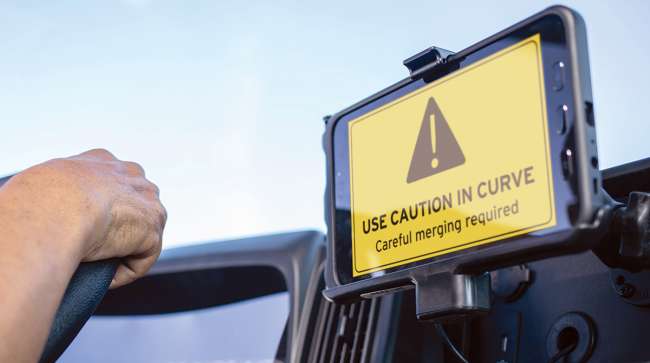Staff Reporter
North Carolina DOT Pilots Trucking Alert System

[Stay on top of transportation news: Get TTNews in your inbox.]
The North Carolina Department of Transportation is piloting an in-cab trucking alert system in an effort to reduce the risk of commercial motor vehicle crashes.
Through a partnership with Intelligent Imaging Systems Inc., the pilot program includes an in-truck messaging system that provides real-time alerts on road conditions. These alerts are meant to help truck drivers prepare for situations including stopped traffic or slowdowns. Based in Canada, Intelligent Imaging Systems is a technology supplier that provides road safety equipment and software services to transportation and law enforcement agencies.
“We strive to let people know of unexpected traffic conditions,” said NCDOT State Traffic Engineer Kevin Lacy. “We’re excited to be working with an industry partner that is using new technology. Truck drivers will be able to get advance warning of a major roadway incident before they see it on one of our dynamic message signs.”
Improving highway & work zone safety, we're piloting an alert system on @NCDOT_I95 & @NCDOT_I40 that warns truck drivers about sudden slowdowns.
Read more https://t.co/MK4tFd4V3j pic.twitter.com/GRYlxGnWFg — NCDOT (@NCDOT) May 20, 2021
The pilot, which will run for a year, covers all 182 miles of Interstate 95 that run through North Carolina, as well as rural portions of I-40 outside the Triangle, the Triad and Asheville. The Triangle refers to the Raleigh-Durham area, which is home to North Carolina State University, Duke University and the University of North Carolina-Chapel Hill. Located in north-central North Carolina, the Triad’s three largest cities are Greensboro, Winston-Salem and High Point. According to the Piedmont Triad Regional Council, new industries emerging in the area include logistics, distribution, aerospace and biotechnology.
The new alerts contain messages warning of sudden slowdowns and congestion about two or three miles before truck drivers encounter an incident. Truckers receive these alerts in addition to other notifications they already get through the Drivewyze system used in the pilot. (Drivewyze is a subsidiary of Intelligent Imaging Systems). Drivewyze safety notifications alert drivers when they are approaching a potentially unsafe condition, such as corridors with a high rollover rate or low bridges.

Next-level technologies hold the potential to enhance safety and efficiency in transportation, but it takes a lot of work behind the scenes to advance these ideas from concept to reality. We talk with Christoph Mertz of the Robotics Institute at Carnegie Mellon and Huei Peng of the University of Michigan. Hear a snippet above, and get the full program by going to RoadSigns.TTNews.com.
One purpose of the pilot is to offer information to commercial drivers at places where they are not near a digital message sign. NCDOT maintains approximately 300 digital signs that provide updates regarding 2,500 miles of roadway.
The alerts are meant to help truck drivers whose vehicles require more time to slow down than passenger cars. According to the Federal Motor Carrier Safety Administration, the average stopping distance for a loaded tractor-trailer traveling at 55 miles per hour is 196 feet. A passenger vehicle traveling at this speed requires 133 feet to safely stop.
North Carolina Division of Motor Vehicles data indicates there were 6,143 tractor-trailer crashes statewide in 2019. NCDOT noted crashes involving tractor-trailers can close highways for long periods and contribute to secondary crashes.
According to NCDOT, the agency will evaluate the pilot’s safety benefits after the program ends in May 2022.
“We’re pleased to partner with the North Carolina Department of Transportation in providing a ‘connected truck’ solution that gives truckers a heads-up on unforeseen slowdowns,” said Brian Heath, president and CEO of Intelligent Imaging Systems. “These alerts will no doubt help with traffic safety along interstates in North Carolina. We’re a company committed to highway safety, and we applaud how NCDOT is the first agency to add these important safety alerts to truckers."
Want more news? Listen to today's daily briefing below or go here for more info:




